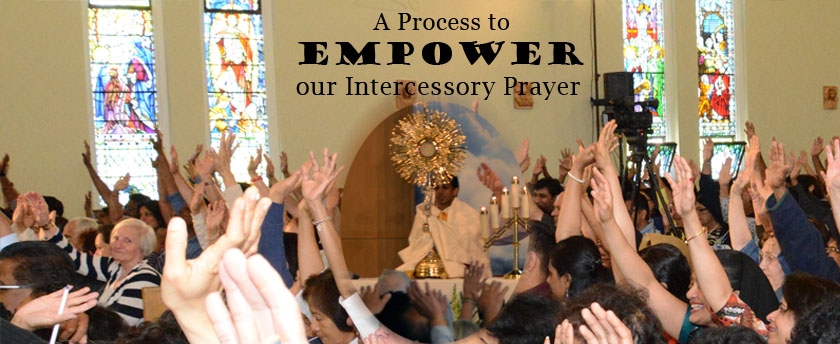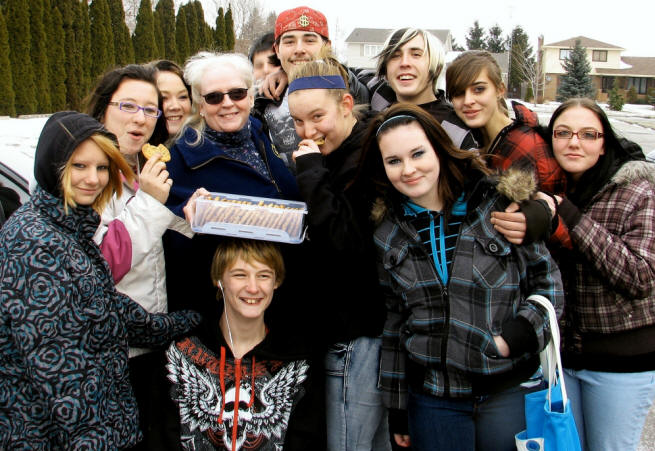Evangelical, seeker, charismatic, emerging
WYH3271HS Winter 2017 March 2, 2017
Links
James Hanrahan on Catholic charismatic renewal in Canada.
Michael Wilkinson on Pentecostalism in Canada.
General changes in the 1960s
The 1960s, often seen as a time of secularization and religious liberalism, was also a springtime for charismatic, evangelical, and seeker expressions of Christianity.
The Charismatic movement
- The charismatic movement began in the 1960s.
- Pentecostal churches are often dated from an outpouring of the Spirit in Azusa Street in Los Angeles in 1906. They influenced the charismatic movement in the mainline churches. There could be some tensions between Pentecostals, who often had a counter-cultural edge, and mainline Protestant charismatics, who could appear more
 accommodated to worldliness.
accommodated to worldliness.
- In Canada, the Pentecostal Assemblies of Canada is the largest Pentecostal group.
- There are also Assemblies of God.
- The Foursquare Church, originating in the ministry of Aimee Semple Macpherson of Salford, Ontario, is also a Pentecostal church.
- In the Episcopal Church, the charismatic movement is reckoned to have begun in 1959 in three congregations in southern California. The clumsy response of the bishop of Los Angeles led to widespread publicity. In 1961 several clergy in Prince Rupert, B.C., were baptized in the Spirit, under the influence of southern California Episcopalians. In 1962 praise meetings began at St. Elizabeth's, Etobicoke, Ontario. By the mid-1970s charismatic renewal was widespread. Anglican Renewal Ministries in Canada was formed in 1983. The 'shepherding body' for the movement in Ontario is the Catholic Charismatic Renewal Services of Ontario.
- In the Roman Catholic Church, the charismatic movement is reckoned to have begun at Notre Dame University in 1967, when a Catholic Pentecostal Conference was held. There were previous charismatic outbreakings at Duquesne University in Pittsburgh and at the University of Michigan. Charismatic renewal spread from there. By August 1968 Madonna House in Combermere, Ontario, had experienced charismatic renewal. A charismatic meeting called Emmanuel Prayer Group was regularly held in the crypt of St. Basil's Church at St. Michael's College, Toronto. A conference of francophone charismatics drew 50,000 in 1977.
- Charismatic Christians experience a direct sense of the Holy Spirit in their lives, leading to energetic prayer and song, and sometimes to other gifts such as speaking in tongues. Charismatic worship may take such forms as prayer meetings, praise services, and anointing for healing.
Evangelical churches
- The Evangelical Fellowship of Canada began in the 1960s.
- his category can include Baptist churches, holiness movement churches (such as the Church of the Nazarene and the Salvation Army), the Christian and Missionary Alliance (founded by A.B. Simpson of Prince Edward Island), the Mennonite family of churches, and the Christian Reformed churches,
- Typically Pentecostals are included as evangelicals, though some classical evangelicals, focused on the authority of Scripture, can be suspicious of appeals to an experience of the Spirit.
- There are about 100 evangelical church denominations in Canada.
- The Evangelical Fellowship of Canada began in 1964, led by Harry Faught, the pastor of Danforth Gospel Temple. His inspiration was the National Association of Evangelicals in the U.S.A.
- The statement of faith of the Evangelical Fellowship of Canada includes the authority of Scripture, the triune character of God, redemption in the blood of Christ, and the last judgment.
Anglican Evangelicalism
The Evangelical Fellowship of the Anglican Communion began in the 1960s.
Anglican evangelicalism by 1960 was typically of a liberal and low-church variety. A revival of Anglican evangelicalism began in the early 1960s. The Evangelical Fellowship of the Anglican Communion (EFAC) was founded in England in 1961 by John Stott (1921–2011), an evangelical pastor, writer, and teacher who served as its general secretary for twenty years. It represented a protestant and Reformed approach to Anglicanism. In 1967 Stott and his more conservative friend (and sometime rival) James I. Packer (b. 1926) organized a conference at the University of Keele, England, which attracted a thousand people, and is frequently seen as restoring evangelicalism to a significant mainstream position within Anglicanism.
Both Stott and Packer directed much of their attention to Canada; the latter, in fact, took up a teaching position at Regent College, Vancouver. In the mid-1980s a handful of Anglican evangelicals from across Canada met at Wycliffe College in Toronto to organize a Canadian affiliate of EFAC. A brief history is here.
Seeker churches
 The Church Growth movement began in the 1960s. Donald McGavran began the Institute of Church Growth in 196. His book The Bridges of God was influential.
The Church Growth movement began in the 1960s. Donald McGavran began the Institute of Church Growth in 196. His book The Bridges of God was influential.
Seeker-sensitive churches connect with visitors by being attractive to persons raised in a secular culture. The best-selling bookThe Purpose-Driven Life by Rick Warren gave a blueprint for this approach, and Warren's Saddleback Church in Orange County, California, is a very large seeker megachurch. Worship with contemporary music and cultural allusions, services such as sports programs and daycare, and supportive small groups and classes are key.
The Meeting House in Oakville, the Meeting Place in Winnipeg, and the Sanctuary in Oakville are examples.
The Toronto Blessing
 In January 1994, at a church near the Toronto airport, worshipping congregations began experiencing a powerful revival involving experineces of being 'slain in the spirit,' holy laughter, the healing of damaged relationships, and other phenomena. Only 120 people were present at first, but the church grew to over a thousand, and influenced similar revivals around the world, including Albania, Cambodia, and the Phillipines. A visitor who was influenced was Nicky Gumbel, developer of the "Alpha Course", an introduction to Christianity which has been credited with helping to convert tens of thousands of people; he is the pastor at Holy Trinity Church, Brompton, in London, U.K.
In January 1994, at a church near the Toronto airport, worshipping congregations began experiencing a powerful revival involving experineces of being 'slain in the spirit,' holy laughter, the healing of damaged relationships, and other phenomena. Only 120 people were present at first, but the church grew to over a thousand, and influenced similar revivals around the world, including Albania, Cambodia, and the Phillipines. A visitor who was influenced was Nicky Gumbel, developer of the "Alpha Course", an introduction to Christianity which has been credited with helping to convert tens of thousands of people; he is the pastor at Holy Trinity Church, Brompton, in London, U.K.
The churc, called Toronto Airport Vineyard, was part of the Vineyard movement begun in the 1980s by John Wimber (1934–1997) of Fuller Seminary in Pasadena, California. The movement became known as "the Thrid Wave of the Holy Spirit," after the Pentecostal movement and the charismatic movement. It emphasized 'signs and wonders'. The pastors of the Toronto Airport Vineyard church were John and Carol Arnott, who were influenced by earlier revivals. The preacher at the first blessing was Randy Clark, who also had had revival experiences. The revivalism waned in about a year. John Wimber regarded the Toronto blessing as inconsistent with the values of the Vineyard movement, and the church was removed from the Vineyard association. The church was renamed Toronto Airport Christian Fellowship, and now "Catch the Fire".
Michael McClymond, "After Toronto: Randy Clark's Global Awakening, Heidi and Rolland Baker's Iris Minstires, and the Post-1990s Global Charismatic Networks," in Pneuma 38 (2016): 50-76, picks up the story. U of T library users can read it here. He identifies churches around the world that have picked up "bodily healing, verbal evangelism, care for the poor, Bible teaching, exuberant worship, 'soaking prayer,' and inner healing," as well as specialized ministries.
Developments in the Catholic charismatic movement
The Catholic bishops of Canada wrote a pastoral letter about the charismatic movement during its 35th anniversary in 2003.
- It validates the spiritual authenticity of the movement, and affirms its values of deep religiousu experience, prayer, evangelization, service to others, and healing.
- The letter also includes some concerns and cautions.
- It observes that God's healing happens not just in extraordinary and rare ways but, much more usually, in common medical ways. It also requires informal services of healing to be clearly distinguished from sacramental anointing as governed by the Church's liturgical norms.
- It appears to worry that some charismatic leaders are a little bossy, The leader understands that sustained long-term results cannot be achieved by ordering people to do things". Leaders should be an attractive and encouraging force.
- .It appears to worry that the movement can become a bit detached from doctrinal norms. Accordingly, it sets down some standards for spiritual and doctrinal formation.
Emerging churches
An article by Steven Studebaker and Lee Beach of McMaster Divinity College, (pdf) "Emerging Churches in post-Christian Canada" in Religions 3 (2012): 867–879, looks at non-institutional Christian fellowships that have disdained both mainstream and evangelical expressions. (They distingiush this from 'emergent' churches, as innovations generated by mainstream churches. The distinction does not seem firm.) These Christians have little use for mainstream and evangelical churches which appear to them to be immersed in program not people, religiously consumeristic, obsessed with the culture wars, lacking in diversity, and "cookie-cutter" in their social codes. 
- Their first demographic they call "Bohemians," who are an artistic people, eco-conscious, progressive, keen on organic and local foods.
- Second are the "metros" or "hipsters," educated, maybe professionals, trendily dressed, in their 20s and 30s.
- Third are the "misfits" who, among other things, feel excluded from the bourgeoise that dominates mainstream and evangelical churches. This includes people with disabilities, who are welcomed to participate fully, and not merely given a space.
They mingle in different kinds of churches:
- Intentional or new monastic communities, like Matthew 25 House in Hamilton, pictured right. .
- Colonizing churches, that revitalize their neighbourhoods.
- Social enterprise churches, such as The Story, in Sarnia. Their church space is used during the week to incubate micro-businesses in the urban core.
- Third space churches, such as the Cafe Church in Kingston, Ontario, which meets in a coffee shop.